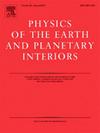Constraining seismic anisotropy on the mantle transition zone boundaries beneath the subducting Nazca slab
Abstract
Some seismic evidence suggests that the mantle transition zone (MTZ) may become highly hydrous and anisotropic, particularly in the vicinity of subduction zones. The two-dimensional path-integrated anisotropy from the upper mantle to the MTZ has been well established beneath the northwestern region of South America. However, explicit details of azimuthal anisotropy on the MTZ boundaries remains ambiguous. Therefore, we attempted to constrain the azimuthal anisotropy on the MTZ boundaries by implementing the P-to-S anisotropic receiver function analysis. We detected significant seismic evidence of azimuthal anisotropy on the 410-km discontinuity, but weak anisotropy on the 660-km discontinuity. The synthetic waveform modeling indicated the fast symmetry axis of anisotropy trends 50° from the north and plunges 40° downwards from horizontal with an anisotropy strength of 4.0% near 410 km depth. The direction of anisotropy suggests the mantle material moves downwards and towards the subducting Nazca slab near the depth of 410 km. The increased anisotropy strength around the 410 km suggests the hydrous wadsleyite may attribute to anisotropy in the upper MTZ. The lack of detectable seismic anisotropy near the depth of 660 km could be caused by the insufficient amount of aligned anisotropic minerals, even though the mantle material continues moving downwards.


 求助内容:
求助内容: 应助结果提醒方式:
应助结果提醒方式:


